Dec 29, 2025
Dec 29, 2025
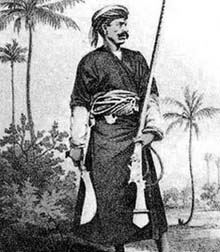 Kodagu (anglicized as Coorg), a fertile mountainous region of Karnataka blessed with natural beauty, is the birthplace of Kaveri River. Nestled in the Sahyadri Mountains of the Western Ghats, this rugged and hilly region is inhabited by a unique group of people with martial traditions. They are a relatively a small community called Kodavas (Coorgs or Coorgis). The Kodavas have fiercely guarded their tradition and customs as well as their uniqueness. Kodavas are the dominant class living in Kodagu though they only form about 15 to 20 percent of the population. There are 100,000 Kodavas in Kodagu with a total population of 545,000. They co-exist with people of other castes and tribes peacefully that include the Yeravas, Kurubas, the aborigines called Kudiyas, the lower caste called Poleyas. The region was later settled by Vokkaligas from Hassan and Chikmagalur, Shettys from Dakshina Kannada, who were businessmen and Mapilles (Moplahs), who are the Islamic converts left over from Hyder Ali and Tippu’s era.
Kodagu (anglicized as Coorg), a fertile mountainous region of Karnataka blessed with natural beauty, is the birthplace of Kaveri River. Nestled in the Sahyadri Mountains of the Western Ghats, this rugged and hilly region is inhabited by a unique group of people with martial traditions. They are a relatively a small community called Kodavas (Coorgs or Coorgis). The Kodavas have fiercely guarded their tradition and customs as well as their uniqueness. Kodavas are the dominant class living in Kodagu though they only form about 15 to 20 percent of the population. There are 100,000 Kodavas in Kodagu with a total population of 545,000. They co-exist with people of other castes and tribes peacefully that include the Yeravas, Kurubas, the aborigines called Kudiyas, the lower caste called Poleyas. The region was later settled by Vokkaligas from Hassan and Chikmagalur, Shettys from Dakshina Kannada, who were businessmen and Mapilles (Moplahs), who are the Islamic converts left over from Hyder Ali and Tippu’s era.
The Kodavas are reputed to be handsome and hospitable, and are hunters and harvesters. In their customs and worship they distinguish themselves as quite different as compared to Hindus, with whom they now identify. They have carved out their own unique society. Kodavas are people who are fond of song, dance and merriment. They have a rich collection of folk songs fit for every occasion, like birth, marriage and festivals.
The Land
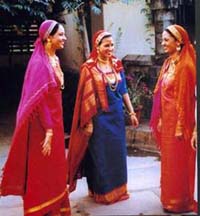 Kodagu is a small mountainous region on the eastern slopes of the Western Ghats. The average altitude ranges from 3000 to 5500 feet. The highest peak is Thadiyanda Mol at 5729 feet. Kodagu is bordered by Tulu speaking Dakshina Kannada to its Northwest, Kannada speaking Hassan District to the North and Mysore to the Northeast. To the South and Southwest are the Malayalam speaking Kannur and Kozhikode districts of Kerala. Thus all three languages have had an impact on Kodagu. The region is drenched with heavy rainfall, along with the coastal Karnataka, a result of the deluge of Southwest Monsoon.
Kodagu is a small mountainous region on the eastern slopes of the Western Ghats. The average altitude ranges from 3000 to 5500 feet. The highest peak is Thadiyanda Mol at 5729 feet. Kodagu is bordered by Tulu speaking Dakshina Kannada to its Northwest, Kannada speaking Hassan District to the North and Mysore to the Northeast. To the South and Southwest are the Malayalam speaking Kannur and Kozhikode districts of Kerala. Thus all three languages have had an impact on Kodagu. The region is drenched with heavy rainfall, along with the coastal Karnataka, a result of the deluge of Southwest Monsoon.
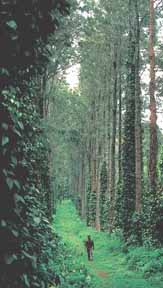 This abundant rainfall has resulted in lush forest growth that is typical of the Western Ghats with its rain forest in this range of mountains. The heavy rainfall is also conducive to growing rice paddy in flatter areas. The wet slopes are also ideal for growing coffee beans. Some of the best coffee estates in South India, first established by the British, are to be found in Kodagu. A drive through the thoroughfare certainly will reward one with natural scenic beauty of canopies of trees and expansive scenery of the mountains. It is also not unusual to see coffee plantations, pregnant with red berries on either sides of the road. Coffee, cardamom, pepper, orange, timber and honey known as ‘Coorg Honey' are the major products of Kodagu. Tea, rubber. Arecanut, coconut, citrus fruits, pineapple, papaya, plantain, piggery and poultry are other products fueling its economy. Kodagu, which is a district of Karnataka State, has three Taluks namely Madikeri, Somavarapete and Virajapete.
This abundant rainfall has resulted in lush forest growth that is typical of the Western Ghats with its rain forest in this range of mountains. The heavy rainfall is also conducive to growing rice paddy in flatter areas. The wet slopes are also ideal for growing coffee beans. Some of the best coffee estates in South India, first established by the British, are to be found in Kodagu. A drive through the thoroughfare certainly will reward one with natural scenic beauty of canopies of trees and expansive scenery of the mountains. It is also not unusual to see coffee plantations, pregnant with red berries on either sides of the road. Coffee, cardamom, pepper, orange, timber and honey known as ‘Coorg Honey' are the major products of Kodagu. Tea, rubber. Arecanut, coconut, citrus fruits, pineapple, papaya, plantain, piggery and poultry are other products fueling its economy. Kodagu, which is a district of Karnataka State, has three Taluks namely Madikeri, Somavarapete and Virajapete.
The Origins
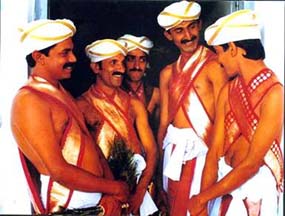 The origin of the Kodava tribe is unknown. Their strange customs, both marriage and death ceremonies, and the kind of worship has spawned many speculations. It is generally felt that they are not indigenous tribes but are mlecchas or foreigners who migrated to the region in the remote past.
The origin of the Kodava tribe is unknown. Their strange customs, both marriage and death ceremonies, and the kind of worship has spawned many speculations. It is generally felt that they are not indigenous tribes but are mlecchas or foreigners who migrated to the region in the remote past.
The most common theories are:
Wherever the Kodavas originated from, it is clear that they maintained a clear and separate identity of themselves for many centuries. Skilled in warfare and cultivation, they formed a society that remained different than that of their neighbors for many centuries.
History
Starting from very early in its history Kodagu has been under various dynasties that typically controlled the neighboring regions of Karnataka. Kodagu has been ruled by the Gangas, Kadambas, Chalukyas, Cholas, Kongalvas and Changalvas (both local prominent dynasties), Hoysalas, Vijayanagara and Nayaks. There is not much historical record of Kodava history or any record of the origins of Kodava people. Most of the history is recorded only after the 16th century.
The earliest mention of Kodagu is in the Sangam literature in the 2nd century A.D., where it is stated that the Pandya kingdom extended west up to Kudukam (kuda meaning west in Tamil). It is believed by historians that Kudukam is Kodagu. Early on the northern part of Kodagu was under the control of Kadambas and the southern regions under the Gangas. Under the protection of Gangas, the Changalva Arasus flourished. The Gangas and the Changalvas were defeated in the 11th century by Cholas. However, under the suzerainty of Cholas, the Changalvas continued to rule the southern regions when Raja Raja Chola was ruling in Tanjavur.
A Kongalva called Nayak Manija had helped the Cholas in their quest to defeat the Gangas. He was made the ruler in some northern areas of Kodagu and Hassan. A century later the Hoysalas of Dwarasamudra defeated the Cholas but the Changalvas did not accept them fully as the rulers. Then Hoysala Bettarasa defeated the Changalva king Pemma Veerappa and made him the vassal of Hoysala Kingdom. Incidentally, it was during the rule of Pemma Veerappa that the region was called Kodagu for the first time. When Hoysala kingdom declined after the Muslim invasion in the 14th century (Alauddin Khilji through his infamous commandant Malik Kafur), the Changalvas became prominent rulers of Kodagu. They however co-existed with the Kongalvas. However, both Changalvas and Kongalvas were nothing more than feudal lords of Kodagu and had no influence beyond its borders.
As an answer to Bahmani kingdom south of Deccan, the Vijayanagara kingdom was established and flourished. Vijaynagara Empire controlled all the lands in South India which were not under the influence of the Bahmani Empire of Bijapur. Kodava kings paid fealty to the Vijayanagara kings and were thus protected. After the defeat of Vijayanagara by the concerted effort of the Muslims, various Nayaks ruled splintered Kodagu until the 16th century.
In the 16th century, in the aftermath of the fall of Vijayanagara Empire, the Keladi Nayaks of Ikkeri consolidated power in Kodagu and established the Paleri (Haleri) dynasty (so called because of their capital in Paleri). Paleri kings, who were Lingayats of Veerashaiva faith, ruled the region for more than 200 years (1580 – 1834). The first ruler of Paleri dynasty was Vira Raja. His grandson Muddu Raja I was a popular ruler and ruled for more than 50years. He moved his headquarters to current day Madikeri in 1681. It was called Muddu Raja Keri and later shortened to Madikeri (anglicized as Mercara). Under the Paleri dynasty Kodagu attained a status as an Independent kingdom.
Dodda Vira Raja (also called Siribai Dodda Vira Raja) ruled from 1687 – 1736. Dodda Vira Rajendra (1780 – 1809) and Linga Raja II (1811 – 1820) also had significant impact on the history of the region. Dodda Vira Raja improved transportation by building bridges across ancient trenches. He also streamlined the administration of the region into villages, districts and appointed district headmen.
In the 18th century, Hyder Ali had usurped the rulers of Mysore and set his sights on Kodagu. A weak ruler called Chikkaveerappa was ruling Kodagu. Hyder Ali grabbed some Kodava land in 1763 but his mighty troops were defeated by the gallant Kodavas in 1766. After Chikkaveerappa’s death the Paleri dynasty was split into Paleri and Horemale and two rulers called Mudduraja and Muddaihraja came to power. After their death in 1770, an internal skirmish between Linga Raja I and a Devappa Raja of Paleri and Horemale respectively, gave Hyder Ali an opening. He sided with Linga Raja I and installed him on the throne and acted as his protectorate. When Linga Raja I died, Hyder Ali took direct control of the Kodavas. This enraged the Kodavas and they started heckling the Muslim garrison in Madikeri. In 1782 the Kodavas took power back from Hyder Ali. In the same year, Hyder Ali died and his son Tippu Sultan started his ambitious expansion of his kingdom.
In 1785, Tippu attacked Kodagu, while returning from Mangalore to Srirangapattana, his capital city. He retained control of Kodagu for sometime.
Tippu never could continuously hold his power in Kodagu. As soon as he turned his back on Kodagu, the local heroes revolted and took power back from the Muslim rulers. Tippu returned to reclaim control though he found the Kodavas a pesky thorn on his sides. Both Hyder Ali and Tippu were interested in Kodagu because of its abundant rice crops. In 1788, Dodda Vira Rajendra, who had been taken prisoner, escaped and defeated Tippu and recovered his kingdom. In 1790 Dodda Vira Rajendra signed a treaty with the British, who promised to protect his kingdom against Tippu’s onslaught. Eventually, the Kodavas backed the British troops and Tippu fell in the year 1799. The Paleri rulers continued to rule until 1834, when the British exiled the last of the rajas, Chikka Vira Raja, and took full control of the region. They charged him with cruelty to his people and sedition as an excuse to annex Kodagu under the British Raj.
Under British protection, Kodagu became a State with nominal independence. Coorgs Bopanna became the first governor and later his descendents assumed the role of administrators. The Kodavas in turn earned a name as valiant soldiers and officers in the army. They earned a reputation as able commanders and brave fighters both under the British rule as well as post independent India. Eventually, famous sons of Kodagu became prominent members of the armed forces of India. General K.S. Thimayya DSO and Field Marshal K.M. Cariappa OBE are both well known names to Indians.
The British found the region to be extremely backward with no decent amenities. They did some improvements but still improvement in educational facilities and infrastructure had to wait for full independence. Kodagu had been directly under British rule and attained statehood shortly after independence. In the early fifties it was a full state with two representatives. In the year 1956, with the division of states according to languages predominant to the region, Kodagu became part of Karnataka.
The legend of River Kaveri
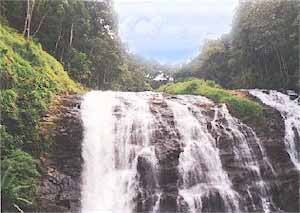 The main river of Kodagu is the legendary Kaveri. River Kaveri has attained a sacred status in Kodagu, not unlike River Ganga in the North. Kaveri takes origin in Brahmagiri hills in Kodagu, in a place aptly called Talakaveri (head of Kaveri). It starts from a small spring (kundike – pond), gathering body as it courses downhill. It is joined by its two tributaries Kanake and Sujyoti. The confluence of these three rivers takes place in Bhagamandala. From here River Kaveri courses through its serpentine route, giving life and sustenance to millions of people, through the states of Karnataka and Tamil Nadu, to eventually drain into the Bay of Bengal on the eastern shores of Tamil Nadu, near Kaveripattinam.
The main river of Kodagu is the legendary Kaveri. River Kaveri has attained a sacred status in Kodagu, not unlike River Ganga in the North. Kaveri takes origin in Brahmagiri hills in Kodagu, in a place aptly called Talakaveri (head of Kaveri). It starts from a small spring (kundike – pond), gathering body as it courses downhill. It is joined by its two tributaries Kanake and Sujyoti. The confluence of these three rivers takes place in Bhagamandala. From here River Kaveri courses through its serpentine route, giving life and sustenance to millions of people, through the states of Karnataka and Tamil Nadu, to eventually drain into the Bay of Bengal on the eastern shores of Tamil Nadu, near Kaveripattinam.
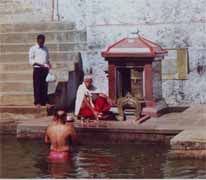 River Kaveri is said to be an incarnate of Goddess Parvati. Lopamudra was an adopted daughter of Sage Kavera. She was given in marriage to Sage Agatsya, who had crossed the Vindhya Mountains and ventured down south. Sage Agatsya is credited with bringing Aryan religion to the southern regions of India. Goddess Parvati had promised Prince Chandravarma, who had propitiated and meditated on her that she would appear in Kodagu as a river. Lopamudra, who was the incarnate of Goddess Parvati, became River Kaveri in Kodagu.
River Kaveri is said to be an incarnate of Goddess Parvati. Lopamudra was an adopted daughter of Sage Kavera. She was given in marriage to Sage Agatsya, who had crossed the Vindhya Mountains and ventured down south. Sage Agatsya is credited with bringing Aryan religion to the southern regions of India. Goddess Parvati had promised Prince Chandravarma, who had propitiated and meditated on her that she would appear in Kodagu as a river. Lopamudra, who was the incarnate of Goddess Parvati, became River Kaveri in Kodagu.
Chandravarma was the son of king Siddhartha of Matsya kingdom. He traveled to various temples like Kanchi, Tanjavur and Chidambaram and came to Brahmagiri hills in Kodagu. Here he performed penance and Goddess Parvati, pleased with his devotion granted him the boon of a horse, a sword and an army. She gave him the power to overthrow the mlecchas (foreigners) and take over the kingdom of Kodagu. She also promised him that she would bless the land with her incarnation in the form of River Kaveri. A Sudra girl was created by Parvati as a bride to the Kshatriya Prince, who bore him eleven sons. The sons married one hundred daughters born to Sudra wives of the Kshatriya king of Vidarbha. The hundreds of children they bore settled in the land of Kodagu, with the blessings of River Kaveri.
The brave grand children of Chandravarma leveled the hills for cultivation with their bare hands like the wild boars. Hence the land came to be known as Kroda Desa (kroda meaning a hog or a boar). This later came to be called Koda Desa and eventually Kodagu. Chandravarma in his old age relinquished his kingdom to his eldest son Devakanta. Thus the patrilineal society where the succession is based on the primogeniture became the practice.
Tula Sankramana (first day of Kodava month of Toleyar – mid October) is celebrated as the day of birth of Kaveri. Legend has it that Parvati appeared in a dream to Devakanta and asked him to gather the family of his father Chandravarma in Balamuri and await her arrival. He did as he was instructed and on the day of Tula Sankramana, River Kaveri came flowing down. The families of Chandravarma bathed in the holy waters of Kaveri and were purified. The force of the water moved the pleats of the saris of women to the rear. Hence the unique habits of the Kodava women of wearing the sari with the pleats in the back and not in the front as commonly worn by Hindu women.
The Kaveri Purana is a part of Skanda Purana, one of the last Puranas written. Some researchers see Kaveri Purana as a way of trying to integrate Kodavas to Hindu society by explaining that they are the progeny of Kshatriya kings and Sudra women. Kodava culture did not recognize the Aryan varnashrama and hence did not have caste systems. This helped to diffuse any friction between Kodavas who were radically different than their Hindu neighbors.
Continued
04-Jul-2004
More by : Dr. Neria H. Hebbar

|
Nice article. I am from Kogadu. Iam very disspointed to see that you have not mentioned about the Brahmins who live in Kodagu. Most of these Tulu Brahmins were brought from Udupi during Linga Raja's time to perform puja at many temples that he built.Please do some research on this and add to the article.Thank you |

|
Haleri ruling start 1600 Are gowda come from tulunad |

|
Good essay |

|
Kodvas are really great.......no one can be like kodavas.....really great people.... |